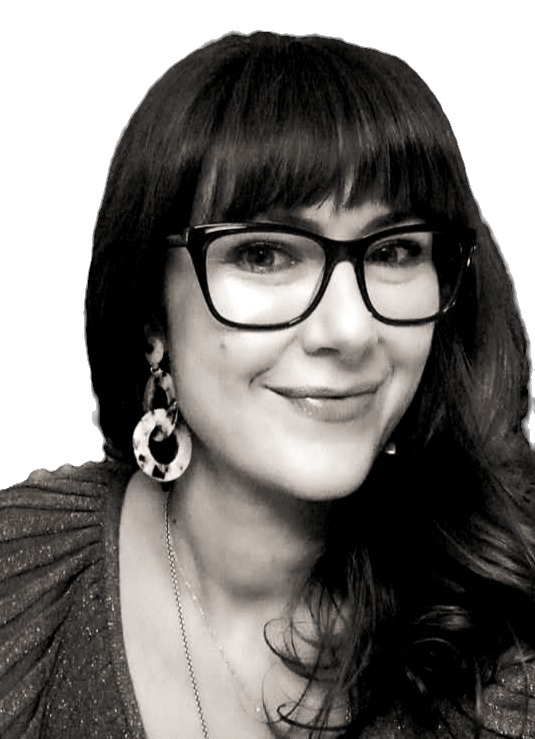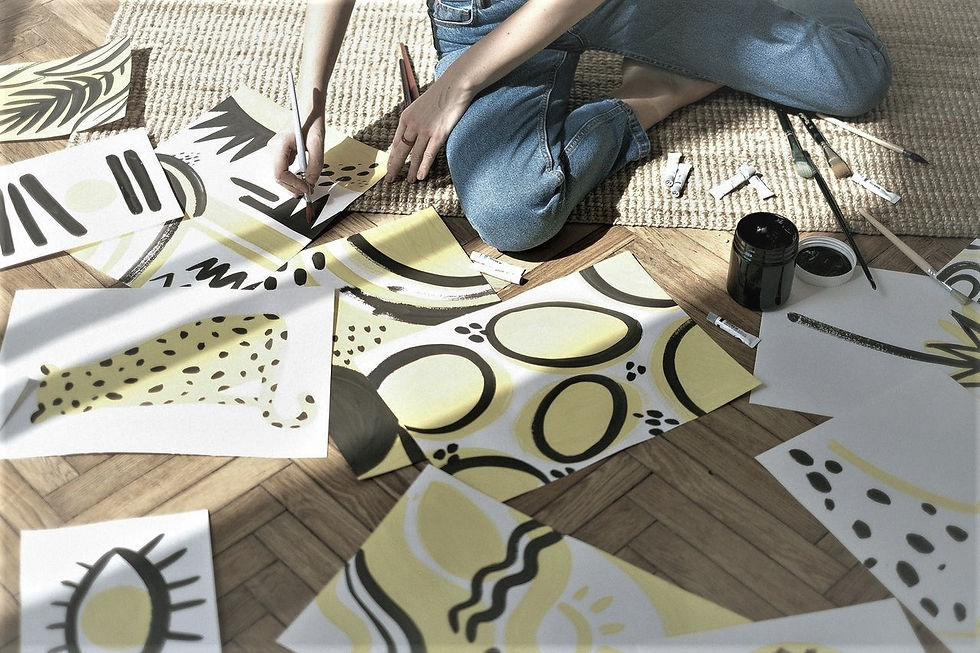What are the stages of the art-making process?
- Bianca Vinther

- Sep 28, 2021
- 7 min read
Updated: Feb 20, 2022
Understanding the creative process in visual arts from concept to completion
How would you describe your creative process in art?

Becoming aware of the steps you walk from concept to completion, and consciously examining each of these steps individually will help you better understand your creative process and its outcomes. It will also boost your artistic creativity and help you find more inspiration for your art.
In this blog post, I’ll break down the art-making process into stages, address the concept of “failure”, and reveal to you the secret to successfully dealing with so-called “bad art”.
There are 3 main stages in the making of art:
1. Find
2. Transform
3. Gift
In this specific order.
You should never start with the end in mind when you make art. So, let’s start with finding (not searching).
1. Find

This is where a new creative process begins. It’s the inception phase, which often starts with a gaze. Look closely and slowly around you and inside yourself. Observe, dive in, and wonder. Don’t forget to listen at the same time. Like the Persian poet Rumi said:
“You look past your thoughts, so you may drink the pure nectar of this moment”.
Collect input from nature, from other visual artists, or from within yourself. Gather things that interest you, speak to you, and awaken your spirit. Then research the things you love, and notice patterns. Make unusual associations between familiar objects, materials, textures, forms, structures, and colours.
Gather plenty of rough ideas – so many potential ways to explore, combine, and transform reality into something else, unique, and meaningful!
In these moments of amazement, excitement, and possibility I feel my creative vibes awakening inside of me. The encounter with The Possible, my attraction to the basic art elements (the point, the line, and the surface), and the colours, textures, and forms I experiment with activate my creative energy. My spirit lifts literally up. I plunge into The Boundless Unknown and come back home. I’m on the vertical axis, the axis of life.
Feeling the same? Then embrace this feeling and sit with it for a while. Cocoon and nourish it, absorb its exciting and invigorating energy!
Not feeling like this at all? Then be more mindful about the first little steps you take in your creative process. Pay more attention to the things around you and within yourself, notice what resonates with you, and how it affects you.
To sum this up, I’ll quote Pablo Picasso’s wise words:
"I do not seek, I find. It is a risk, a holy adventure. The uncertainty of such ventures can only be taken on by those, who feel safe in insecurity, who are leaders in uncertainty, in guilelessness, who let themselves be drawn by the target and do not define the target themselves."
What does it mean to me to find? It means to look inward, to “go beyond my form”, and to identify unique solutions to my questions within my creative Self. It means to see reality differently – to rediscover the world anew each time. It means to recognise.
To find also means to choose and reinvent. But to choose and reinvent is not to make. To me, it means to transform an ordinary thing into something extra-ordinary; to take a thing out of its familiar context, to dissociate it from its initial function, and to change something about it. In other words, it means to give a thing another life.
2. Transform: develop – make your artworks – complete

2.1 Develop
It’s in this phase that you start feeling inspired and must take further action: sketch frenetically. Because every wasted breath of inspiration is a wasted chance to make art. Put down your marks, your visual language, and gather lots of threads.
Once your creative energy is awakened, narrow down the spectrum of possibilities. An intuition of the way you want to walk begins to emerge. Follow it and continue to sketch, sketch, sketch. Then choose the most exciting concepts, marks, and colour combinations to work with. Continue to distill and transform the inputs and elements you’ve collected so far into something different.

2.2 Make your artworks
Now you know you’re ready to make the actual artworks. This is a pivotal phase in your creative process.
My breath stands still for a second before the rocket takes off. There’s something holy and frightening about the moment when I begin to transfer my sketches onto canvas or paper. It’s like sitting at the piano quietly, listening in, and beginning to hear the gentle voice of music whistling in my ears before I start to play my repertory.
Have you felt like this before? Then you know that the only thing you need to do now is to dare to go further.
I personally love to work on several paintings at the same time. Instead of channeling my complete focus into one single work over many days or weeks, I prefer to spread my creative energy and inspiration over several paintings simultaneously. It’s like playing a whole repertory instead of a single piece of music to perfection.
Therefore, my expert tip is: work on several drawings, paintings, sculptures, installations in parallel: it will take the pressure off yourself, unlock your artistic creativity, and help you play more freely with your ideas, intuitions, marks, colours, and surfaces.
There are 3 main advantages for me in doing this:
1. I don’t obsess on one painting,
2. I avoid overworking it, and
3. I can easier detach myself from it (which helps me see my art with fresh eyes and change the way I initially perceived it).
The outcome is often rewarding: my paintings share a common vision, but each of them has its own character. At first sight, they give the impression of a relatively unified whole. Seen from close, they reveal themselves as individual and unique artworks. Try it for yourself!
How to deal with failed works
You make a choice, you carry out an action, decision after decision in an uninterrupted flow of creative energy, focus, and joy. There’s so much playfulness involved in it! There’s inspiration and spontaneity in every mark you make!
But there’s a flip side to this, too, which is called failure. I rather prefer to call it a chance because a dead-end always redirects you towards a new horizon; it blocks a path but leads, indirectly, to another one. Therefore, I urge you to embrace your failed works, to love your “bad art”, and to see that as a unique opportunity for future achievements.
Have you hit a dead end? Embrace it and be happy about that. Start all over again, erase or just convert, “keep on the ball” (we say in German), and move forward with your creative process. This is the secret to successfully dealing with failed works.
Don’t mind if your works “are not good enough” or even “failed”. Keep going, stay in the flow, and let your inspiration grow. Larry Poons, an artist with a solid vision in colour, rightfully said:
“A failed painting is better than one that’s just plain bad. The failed painting is one that could have been great.”
There’s no straightway to the art you’d love to make, for trial and error are an integral part of the game. There’s no other secret to turning so-called failures into success but this:
LOVE your artist blocks, moments of feeling uninspired, and failed works because they’re unique chances and amazing opportunities for profound change. And change is ultimately art, for art’s fundamental trait is deeply rooted in the principle of metamorphosis. Art is transformative and transformational at the same time.
2.3 Complete
You’ve explored, shaped, and moulded forms, materials, colours, and dreams along the way. Now you know that the process you’ve been so mindfully engaged with is completed but not ended. You know that there’s nothing more to add and nothing left to take away. Your artworks speak for themselves.
How does it feel? Are you happy, content, at peace? Or rather unsatisfied? Could it have been better, nicer, brighter, more sophisticated, simpler? Or is it OK just as it is?
When my work is completed, this is what I tell myself: you’ve learned the lesson, and you’ve enjoyed the experience thoroughly. Now be happy and thankful. So, I listen to the gentle voice of gratitude, and I express it loudly.
3. Share

Finishing the artwork is not the end, but the beginning of a new and unpredictable adventure on a larger scale, which involves a wide community. Make a gift to the world: let us all see your art, know about it. Give us all a chance to explore its depth.
Spread pictures of your artworks generously. Give them with a genuine wish to make a difference in the world. But first and foremost, dare. It took me years until I dared to share my art online. I was freaking scared of other people’s opinions on my paintings. I imagined how my works would be judged mercilessly. One glorious day I decided to let go of my fears and chose to upload pictures of my artworks on Instagram. I was thrilled.
I’ve never thought so deeply about the importance of sharing my art with you until I read Seth Godin’s book The Practice. I’m deeply thankful to the author for his priceless lesson.
Are you ready, hesitating or have you already crossed the Rubicon?
A short recap
To better understand your creative process, make artworks you love, and stay creative in the long run, you need to look around and inside you, reconnect with your creative Self, listen, and let yourself be led. Zero resistance and no end in mind.
Remind yourself that you must push the refresh button every time your creative vision becomes hazy or opaque. Go back to your “why” : what is your “why”, your reason to make art? The answer will keep you grounded and will help you to push your art-making process further.
Constant creative chaos is exhausting. Therefore, you should learn those strategies that can help you along the way. What about trying The Pointless Artist’s time-tested methods and effective tips?
Change habitual thoughts into new ones; unlearn what you’ve learned before, refresh your mind, and shift your vision; then transform familiar things into unconventional ones, and don’t stop there: gift the world with your art.
In short: find, transform, gift, then repeat the cycle all over again, and again.
Thank you for reading till the end. If you’ve got something to add, please comment on this blog post below, drop me an e-mail, or pm me on Instagram @the_pointless_artist. I'd love to hear from you!
To stay tuned and never miss a blog post, sign up for The Pointless Artist’s email list below.
Recognise your pointlessness and keep creating!
Recognise your "pointlessness" and keep creating!
From Germany with love,
Bianca Vinther
What to read next
Need to better understand artistic creativity and the difference between creativity and inspiration? Read my blog post entitled "Creativity in art: the ultimate overview to understanding the foundation of your art".

